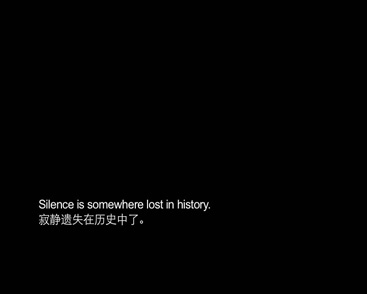
Born in 1973 in Brussels (BE). Lives and works in Brussel (BE)

2007
Mini DV, sound video, text english and chinese
durée : 13'12''
Year of Purchase: 2008
Mira Sanders entitles the totality of her practice with the phrase: journal d’un usager de l’espace [the journal of a user of space]. “Attempting to define one’s work with words is probably one of the most difficult things,” she wrote. “But to attempt to define what one sees is even more difficult. The journal of a user of space is a phrase that came to me as I was reading the French writer George Perec’s Espèces d’espace [Sorts of Spaces]. Perec’s book deals with the perception of our daily lives, from microcosm to macrocosm; confronting our culture; questioning our cultural conditioning, our ways of seeing, and realizing that we are perhaps victims of our own cultural conditioning.”
From the start, this concept in itself announces the direction of her work and determines the foundations of an intrinsically personal and decisively protean work. First, it provides the format (which is more than a medium, but a custom): the “journal” which is a notebook, a place of writing inherently tied to life, to subjectivity, and to the being in the world. The matter of the journal is closely tied to the real as much as it is to the invention of a territory. It combines notes, drawings, videos, interviews, photographs, sound bites, or installations… it’s a world bound to the time of experience that it reconstructs and reexamines. The journal of a user of space designates a heterogeneous practice whose point of interest rests in the artist’s interpretation of an open environment, of a polysemic space that is at once geographical (cultural), sensory (felt), social (tied to encounter). . . The journal invariably is the signature of Mira Sanders’ connected, attentive, and responsive presence.
The video Silent China constitutes a chapter of this journal and is thus connected to other “pages”. The film opens with a journey to China (to Shanghai and Xiamen); it is thus engendered by a sentiment relative to an encounter with foreign culture and unknown language. It draws its source from its incapacity to produce an image, a photograph, or a film in a country where everything seems to elude knowledge. In order to capture this new environment, the artist relies on what she hears: “I listened, and visualized my observations through drawings and notes. Trying to visualize what I had heard but also trying to understand a new culture and explore the possibilities of [its] system.” In a graphic translation and presented as editions or drawings during their exhibition in Brussels (2006), these transcriptions of sounds or words depicting an auditory universe are a detailed rendition of a landscape experienced blindly.
It was during the exhibition “By this I send you some noise of the city I am in” in Xiameh in January 2007 that the video Silent China joined the production of editions, paintings, and drawings which until then had constituted this experience of subjective transcription. Written words and recorded sounds succeed one another against a black background which paradoxically could conjure all the images through their absence. The same utterances in English and in Chinese: “Their washing machines sound like the waves of the sea”; “The street musician is playing a saxophone on the Huahai lu”; “Silence is somewhere, lost in history”. . .
Sentence after sentence, the contours of this mental country sharpen. The point of view unravels the thread of a sensory geography which, disposing of the authority of images, relies on language in order to elicit within each viewer their own representation.
Guillaume Mansart